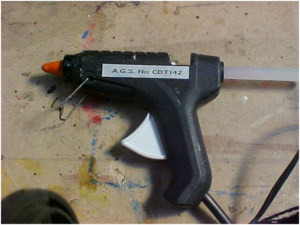Glue guns are mobile utensils that deliver hot melted adhesives.
Thermoplastics taking the shape of cylindrical sticks for use in glue guns were first introduced in the early to mid 20th century as an improvement on traditional water-based glues, which would ultimately weaken due to atmospheric humidity.

Industrial adhesives were then later used in the shoe manufacturing process, although it soon came to be realized that their use was applicable in things involving numerous other materials, including cloths and woods.
For the Best Results
Holt-melt adhesives are vital in glue gun applications. Hot melts can vary, changing in size and form, and include resins, polymers, and various waxes. These melts are particularly useful due to their waterproofing and to their ability to deal with varying chemical environments.
Glue Guns in Action
The glue gun process is relatively straightforward. The thermoplastic sticks are pushed through the rear end of the device and then undergo a melting process taking anywhere between one and five minutes. However, when preheated, this process can often be quickened. In the cheaper and more accessible glue guns, the temperature of the thermoplastics is controlled by an in-device thermistor which limits the heat available. This then, in turn, allows the user to use the glue gun without running the risk of being burnt through excessive heating.
The glue is then forced through a conical tip which can absorb heat very quickly. As a result, many manufacturers include a proactive barrier that covers the tip which reduces the chances of burns occurring.
At the point of application, because the plastic is obviously a solid at room temperature, it solidifies quickly on expulsion from the gun.
Glue guns are particularly useful, due to their ease of use, informing airtight seals and you can find them in a variety of sizes.
For Your Consideration
It is vital you ensure you select the optimal glue for each and every application. For example, lower-temperature glue guns that melt at around 250 degrees are best used for delicate materials, including cloths and thin woods. Higher-temperature glue guns that can reach anywhere up to 400 degrees are more appropriate for use in projects involving harder materials such as wood. Glue guns with varying temperature levels are available for special projects where some versatility is required. You should also ensure that the items that you are using the hot glue on are appropriate to do so on. For example, you are much better off contacting a Boiler Repair Gloucester company such as hpr services ltd rather than using hot glue on a part of your heating system. But you may want to use it to reattach a broken oven or fridge handle.


